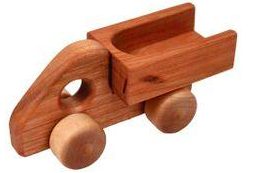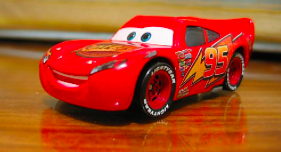I love Lightning McQueen. Don’t get me wrong. I’ve seen little boys cherish their Lightning McQueen thermoses and sleeping bags with a touching affection that always makes me smile. But today I’m going to shamelessly use McQueen as a scapegoat to help me talk about natural toys for children.
So, here we have two toy vehicles. On the one hand, a bright red plastic Lightning McQueen toy, complete with a voice, eyes, name and whole ready-made personality as seen in the movie Cars.
On the other hand, we have a plain wooden truck by Michigan company Camden Rose. No bells or whistles. Just a wooden truck.
Which toy, plastic or wooden, gives a child a richer playing experience? Let the races begin!
As a teacher of young children, I would have to say the wooden truck hands down. Sorry McQueen, but many alternative early childhood education philosophies recommend simple, natural toys for children, and my own experience confirms that these simple toys paradoxically inspire the most dramatic, inspired, and richest imaginative play.
1. Imagination is enhanced with wooden toys
Although there’s certainly nothing inherently sinful about a child’s love for Lightning McQueen, you have to admit the red toy car pictured can’t be anything but Lightning McQueen. It forces an adult’s creation on the clear limitless mind imagination of the child. The Camden Rose car can be anything- a fast car, an old dump truck, the Batmobile or a fire truck or even Lightning McQueen himself, the list of possibilities is infinite. Waldorf education calls this kind of infinite imaginative play “inner picturing abilities.” Basically the more a child can make his own pictures in his mind, the more he is working his brain. Reggio Emilia education calls a toy that inspires this play an “open-ended material.” But no matter what you call it, it simply means a toy that can be transformed.
The inner picturing inspired by the Lightning McQueen toy is limited to… well, Lighting McQueen. Pretty basic. Yet at the same time all the colors, eyes, and sounds can be overstimulating to the child. It can be hard for a young child to concentrate on their play with a toy this complicated. The Camden Rose toy does only a few things: you can make it go, you can put stuff in it. Easy to concentrate on those two tasks and move on into the realm of imaginary play where the real inner development begins.
2. Children learn about weight, mass and touch with wooden objects
According to both Waldorf and Montessori education, the material from which a toy is made has a big impact on the child’s experience playing with it. Plastic can look like wood, metal, jewels, ceramic, fur. But it will always weigh and behave like plastic and this creates a false sense of weight, mass and touch. A toy made of wood will behave like wood, so a child gets real information about her world when playing with a wooden toy.
3. Children learn to respect natural beauty with wooden toys
In addition, cold hard plastic is not a beautiful or rich sensory experience. Wood, cotton, silk, wool and other natural materials are warm and lovely to behold and to touch. Waldorf education in particular attaches a lot of importance to the beauty of a toy. The idea is that children will respect a beautiful, warm object more and have more value for possessions and even “reverence for life,” a big deal in the Waldorf book.
4. Say goodbye to ugly toxins! Wooden toys do not contain harmful chemicals.
Wooden toys also have far less toxins than plastic, and that is very important when babies come into the picture. Take these two teethers below.
A plastic teether can easily have BPA, PVC and phthalates. Let’s take a quick moment for Plastics 202: BPA is actually a chemical that mimics hormones and the body reacts to them the same way as it would to an extra hormone dose. PVC is an extremely common plastic and just plain toxic. Phthalates are added to plastics to make them soft and supple and many teething toys have them. The bad news is they card-carrying cancer-causing carcinogens. Of course not all plastic teethers are toxic; there are many eco-plastic teethers out there. But you really have to do your research to find them, and even more if you want to be absolutely certain they are as safe as they claim to be.
A crocheted or wooden teether like the above from Camden Rose has none of these toxins and is perfectly safe for your baby to gnaw on and drool over in peace. Not to mention this teether does not have little bits, parts, eyes and knobs to come off and choke anybody.
The Winner? Wooden toys capture the checkered flag!
I’ve found that in the case of children’s’ playthings, less is more. And for me as a teacher, that’s wonderful news. Sometimes simple really is better! Sorry Lightning McQueen… sometimes the turtle wins the race after all.
Blog Contributor:
Brooke Bailey




